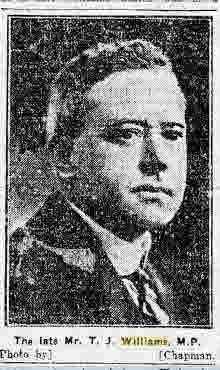1919 Swansea East by-election
The Swansea East by-election, 1919 was a parliamentary by-election held for the British House of Commons constituency of Swansea East on 10 July 1919.
Vacancy
The seat had become vacant when the Coalition Liberal Member of Parliament (MP) Thomas Jeremiah Williams had died on 12 June 1919, aged 46. He had held the seat since its creation at the 1918 general election.
Electoral history

T.J. Williams
| Party | Candidate | Votes | % | ± | |
|---|---|---|---|---|---|
| C | Liberal | Thomas Jeremiah Williams | 11,071 | 63.6 | N/A |
| Labour | David Williams | 6,341 | 36.4 | N/A | |
| Majority | 4,730 | 27.2 | N/A | ||
| Turnout | 17,411 | 64.1 | N/A | ||
| Registered electors | 27,185 | ||||
| Liberal win (new seat) | |||||
| C indicates candidate endorsed by the coalition government. | |||||
Campaign
At a Labour Party conference in June, a resolution was passed in favour of using the strike weapon for political purposes.
Result
The Coalition Liberal candidate, David Matthews, held the seat for his party, but with a greatly reduced majority.
| Party | Candidate | Votes | % | ± | |
|---|---|---|---|---|---|
| C | Liberal | David Matthews | 9,250 | 53.1 | -10.5 |
| Labour | David Williams | 8,158 | 46.9 | +10.5 | |
| Majority | 1,092 | 6.2 | -21.0 | ||
| Turnout | 17,408 | 64.0 | -0.1 | ||
| Registered electors | 27,185 | ||||
| Liberal hold | Swing | -10.5 | |||
| C indicates candidate endorsed by the coalition government. | |||||
Aftermath
David Williams stood again at the 1922 general election and won the seat for the Labour Party.
gollark: Bitcoin mining works by randomly generating data until it hashes to a value with many leading zeros, basically.
gollark: Well, the specific way bitcoin uses it.
gollark: It can be parallelized, yes.
gollark: Bitcoin ASICs just have all the logic for SHA256, directly burned (well, magically siliconed) into hardware.
gollark: CPUs do tons of difficult complex stuff to run general purpose code very fast.
See also
References
- Craig, F. W. S. (1969). British parliamentary election results 1918-1949 (1 ed.). Glasgow: Political Reference Publications. ISBN 0-900178-019. Page 542
Further reading
- Craig, F. W. S. (1983) [1969]. British parliamentary election results 1918-1949 (3rd ed.). Chichester: Parliamentary Research Services. ISBN 0-900178-06-X.
- Leigh Rayment's Peerage Pages
- A Vision Of Britain Through Time (Constituency elector numbers)
This article is issued from Wikipedia. The text is licensed under Creative Commons - Attribution - Sharealike. Additional terms may apply for the media files.